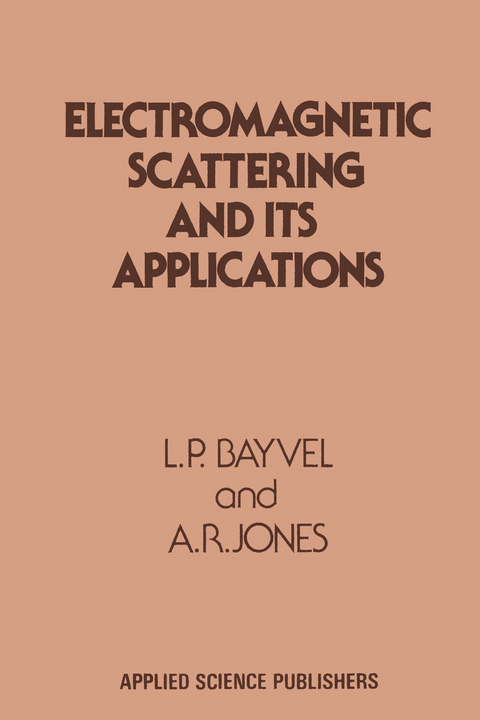
Electromagnetic Scattering and its Applications
Springer (Verlag)
978-94-011-6748-2 (ISBN)
Whenever a wave encounters an obstacle a number of processes occur. For large objects we envisage reflection and transmission with refraction and, in ·many cases, absorption. These phenomena can be described with the aid of ray tracing or geometrical optics, but they do not completely describe the interaction. Diffraction also occurs, and this can only be described by the properties of waves, wave optics. When the object is less than or of the order of the wavelength these processes cannot be so simply understood. The whole interaction is governed by wave optics, and the interactions are lumped together under the heading 'scattering'. Associated with the above there may be changes in frequency of the wave. This may arise due to the Doppler effect if the obstacle is moving or changing in time in any way. Also there can be changes in the energy of the object which must be matched by the wave, such as, for example, in the Raman effect.
1. Scattering of Radiation by Particles.- 1.1 Interaction of radiation with single particles.- 1.2 Interaction of radiation with particle clouds.- 1.3 Electromagnetic wave propagation.- 1.4 General scattering relationships.- 1.5 General scattering theory.- 1.6 Approximation methods in scattering.- 1.7 Multiple scattering and radiative transfer.- 1.8 Anisotropy.- 1.9 Irregular particles.- 2. Radiative Transfer in Particle Clouds.- 2.1 Radiation emitted by sources.- 2.2 Radiative transfer between source and sink.- 2.3 The equation of radiative transfer.- 2.4 Radiative transfer in the absence of multiple scattering.- 2.5 Radiative transfer in the presence of multiple scattering.- 3. Methods of Measuring Particle Size Distribution.- 3 1 Methods of measuring dispersity of solid and liquid particles.- 3 2 Photographic and holographic methods for measuring particle sizes.- 3.3 Methods based on the Fraunhofer diffraction pattern.- 3.4 Methods based on anomalous diffraction.- 3.5 The Phillips-Twomey inversion method.- 3.6 The Backus-Gilbert inversion method.- 3.7 Comparison of the inversion methods.- 4. Measuring Instruments and Data Processing for the Determination of Particle Size Distribution.- 4.1 Swithenbank’s method.- 4.2 Shifrin’s method.- 4.3 The Shifrin-Kolmakov method.- 4.4 The Shifrin-Perelman method.- 5. Other Measurements using Light Scattering.- 5.1 Laser fringe anemometry.- 5.2 Measurement of refractive index.- 5.3 Measurement of anisotropy.- 6. Measurement of Particle Characteristics in Industry and Research.- 6.1 A study of steam turbine operation.- 6.2 A study of gas turbine blade cooling.- 6.3 Determination of drop size spectrum in sprays.- 6.4 Determination of the size distribution of drops in a natural gas stream.- 6.5 Determination of contamination inoil products.- 6.6 Determination of the spectrum of mercury drop sizes in HV gas discharge devices.- 6.7 Measurement of particle size in a flame.- 6.8 Estimation of aggregate size of carbon black by the dispersion quotient method.- 6.9 Measurement of crystal growth rates.- 6.10 Determination of the size distribution of liquid aerosols.- 6.11 Kinetic measurements in aerosols.- 6.12 Determination of the size distribution of atmospheric aerosols.- 6.13 Determination of particle size in seawater.- 6.14 A study of the efficiency of dust collectors.- 6.15 A study of processes taking place in wet scrubbers.- References.- Author index.
| Zusatzinfo | XVI, 290 p. |
|---|---|
| Verlagsort | Dordrecht |
| Sprache | englisch |
| Maße | 152 x 229 mm |
| Themenwelt | Schulbuch / Wörterbuch |
| Geisteswissenschaften | |
| Naturwissenschaften ► Physik / Astronomie ► Elektrodynamik | |
| Sozialwissenschaften | |
| ISBN-10 | 94-011-6748-6 / 9401167486 |
| ISBN-13 | 978-94-011-6748-2 / 9789401167482 |
| Zustand | Neuware |
| Haben Sie eine Frage zum Produkt? |
aus dem Bereich


